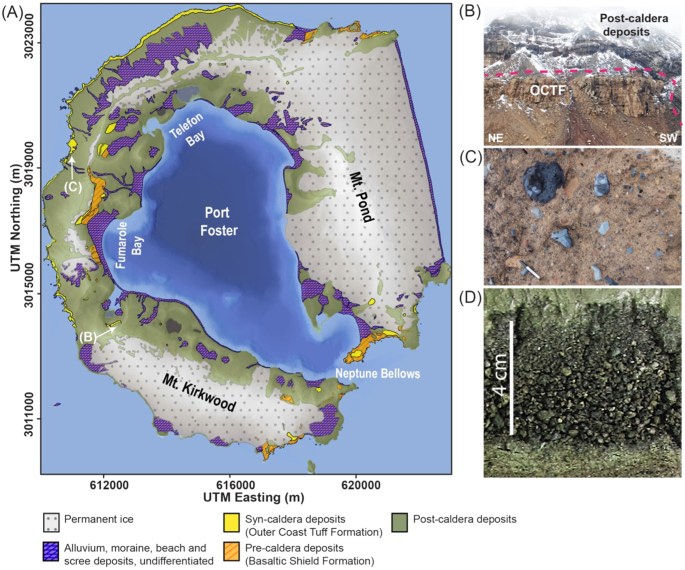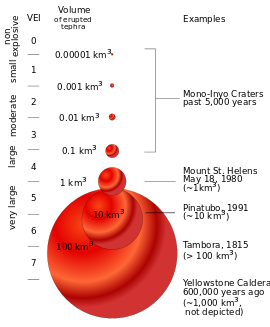Large Volcanic Eruption Shook Deception Island 3,980 Years Agohttps://phys.org/news/2018-11-large-volcanic-eruption-shook-deception.html A large volcanic eruption shook Deception Island in Antarctica 3,980 years ago, and not 8,300, as it was previously thought
A large volcanic eruption shook Deception Island in Antarctica 3,980 years ago, and not 8,300, as it was previously thought, according to an international study published in
Scientific Reports, in which researchers from the Institute of Earth Sciences Jaume Almera (ICTJA-CSIC) have participated.
This event was the largest eruption in the austral continent during the Holocene (the last 11,700 years after the last great glaciation on Earth), and was comparable in volume of ejected rock to the Tambora volcano eruption in 1815. The eruption formed the caldera of the volcano, one of the most active in Antarctica, with more than 20 eruptions registered in the last 200 years
 According to the new study, a volcanic caldera collapse took place 3980 years ago.
According to the new study, a volcanic caldera collapse took place 3980 years ago. The emptying of the magmatic chamber, the zone of magma accumulation that fueled the eruption, during this violent eruptive event caused a sudden pressure drop, triggering the collapse of the upper part of the volcano. As a result, a depression between eight and 10 kilometers in diameter was formed, which now gives Deception Island its particular horseshoe shape. The caldera collapse would have caused a seismic event of great magnitude, the traces of which were recorded in the sediments accumulated in the lake bottoms of Livingstone Island.
The study estimates that the eruption had a volcanic explosive index (VEI) around six, which possibly makes it the largest known Holocene eruptive episode in the Antarctic continent.
"
This colossal episode of eruptive caldera collapse ejected between 30 and 60 cubic kilometers of ash, comparable in volume to the eruption of the Tambora volcano in 1815, an event that is attributed to a global temperature cooling that resulted in a series of bad harvests in Europe, in what is known as the 'year without summer,'" explains Adelina Geyer, ICTJA-CSIC researcher and co-author of the study.
Open Access: Antoniades, D., Giralt, S., Geyer, A., Alvarez-Valero, A.M., Pla-Rabes, S., Granados, I., Liu, E.J., Toro, M., Smellie, J.L. and Oliva, M. (2018).
The timing and widespread effects of the largest Holocene volcanic eruption in Antarctica.
Scientific Reports. (

1.
Read more at:
https://phys.org/news/2018-11-large-volcanic-eruption-shook-deception.html#jCp---------------------------------
I wonder if this is related ...4.2 Kiloyear Eventhttps://en.wikipedia.org/wiki/4.2_kiloyear_eventThe 4.2-kiloyear BP aridification event was one of the most severe climatic events of the Holocene period.[1] It defines the beginning of the current Meghalayan age in the Holocene epoch. Starting in about 2200 BC, it probably lasted the entire 22nd century BC. It has been hypothesised to have caused the collapse of the Old Kingdom in Egypt as well as the Akkadian Empire in Mesopotamia, and the Liangzhu culture in the lower Yangtze River area.[2][3] The drought may also have initiated the collapse of the Indus Valley Civilisation, with some of its population moving southeastward to follow the movement of their desired habitat,[4] as well as the migration of Indo-European speaking people into India.[5]
A phase of intense aridity about 4.2 ka BP is recorded across North Africa,[6] the Middle East,[7] the Red Sea,[8] the Arabian Peninsula,[9] the Indian subcontinent,[4] and midcontinental North America.[10] Glaciers throughout the mountain ranges of western Canada advanced at about this time.[11] Evidence has also been found in an Italian cave flowstone,[12] the Kilimanjaro Ice sheet,[13] and in Andean glacier ice.[14] The onset of the aridification in Mesopotamia about 4100 BP also coincided with a cooling event in the North Atlantic, known as Bond event 3.[1][15][16] Despite this, evidence for the 4.2 kyr event in northern Europe is ambiguous, suggesting the origin and effect of this event is spatially complex.[17]
 Central Greenland reconstructed temperature. Unlike the 8.2-kiloyear event, the 4.2-kiloyear event has no prominent signal in the Gisp2 ice core that has an onset at 4.2 ka BP.Hypothesis: Cooling in the SH? > change in ocean circulation overturning? > change in AMOC? > change in global climate?
Central Greenland reconstructed temperature. Unlike the 8.2-kiloyear event, the 4.2-kiloyear event has no prominent signal in the Gisp2 ice core that has an onset at 4.2 ka BP.Hypothesis: Cooling in the SH? > change in ocean circulation overturning? > change in AMOC? > change in global climate?